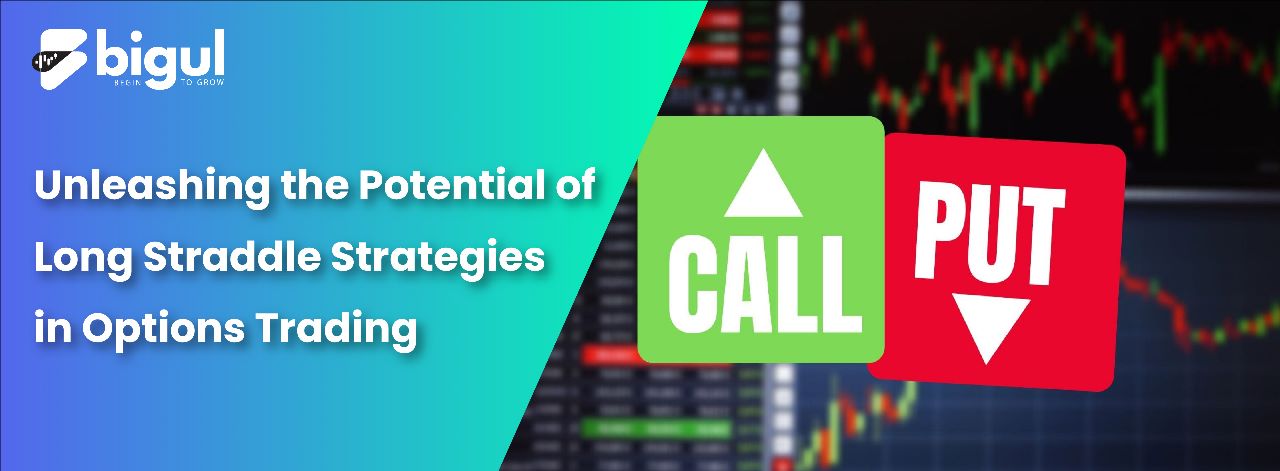Options trading is a flexible and dynamic investment approach that lets traders’ profit from market swings. The long straddle is unique among all the strategies. In a long straddle, traders buy both calls and put options on the same underlying asset, hoping for high price volatility and gains.
Trading a long straddle requires knowledge of volatility and time decay. This article discusses the long straddle’s components, construction, and subtleties.
Also Read | Understanding Options Trading Strategies: Short Straddle
What is the Long Straddle Strategy?
The long straddle strategy involves purchasing both a call option and a put option on the same underlying asset with the same expiration date and strike price.
This strategy is employed when traders anticipate significant price volatility but are unsure about the direction of the asset’s movement. By owning both options, traders aim to profit from substantial price swings in either direction.
The long straddle strategy allows traders to benefit from volatility without taking a directional bias, making it a versatile approach in uncertain market conditions.
Factors to Consider in Long Straddle
A long straddle strategy, which involves buying a call and a put option with the same strike price and expiration date, has various aspects to consider. Important factors include:
- Volatility: Look for high levels of volatility in the underlying asset. This strategy benefits from significant price movements in either direction.
- Time: Choose an expiration date that allows sufficient time for price movement. The longer the time until expiration, the more opportunities for the asset price to make significant moves.
- Strike Price: Select strike prices for both the call and put options that are close to the current market price of the underlying asset. This maximises the potential for profit if the asset price moves significantly.
- Cost: Consider the total cost of implementing the strategy, including the premium paid for both the call and put options. Ensure that the potential gains outweigh the costs.
- Directional Bias: The long straddle strategy is designed to profit from large price swings in either direction. Avoid having a strong directional bias for the underlying asset, as the strategy requires a significant move in either direction to be profitable.
- Implied Volatility: Evaluate the implied volatility of the options. Higher implied volatility increases the cost of the options but also enhances the potential for larger price swings, which benefits the strategy.
- Risk Tolerance: Assess your risk tolerance and the potential downside of the strategy. Long straddles can result in significant losses if the underlying asset’s price remains relatively unchanged.
- Catalysts: Identify potential catalysts or events that could trigger significant price movements in the underlying asset. Earnings announcements, product launches, or regulatory decisions are examples of events that can influence volatility.
Long Straddle Construction
The long straddle strategy includes buying calls and put options on the same asset with the same expiration date and strike price. Let’s use an example to build a long straddle strategy:
If you think Company XYZ is about to announce earnings, you expect a big price move but don’t know which way. You use a long straddle strategy with the stock at Rs 100.
Step 1: Identify the Options
You purchase one call option and one put option on Company XYZ. Both options have the same expiration date, let’s say in one month, and the same strike price of Rs 100.
Step 2: Calculate the Cost
Assume the call option costs Rs 5 and the put option costs Rs 4. To implement the long straddle, you would pay a total premium of Rs 9 (Rs 5 + Rs 4) per share.
Step 3: Profit and Loss Scenarios
Now, let’s consider different scenarios at expiration:
- Bullish Scenario: If the stock price increases much above Rs 109 (Rs 100 + Rs 9), the call option will be in-the-money, and you can exercise it for a profit. The put option expires worthless, losing the premium paid. The premium (Rs 9) limits the loss.
- Bearish Scenario: If the stock price drops sufficiently below Rs 91 (Rs 100 – Rs 9), the put option will be in-the-money, and you can exercise it for a profit. The premium paid will be lost when the call option expires worthless. Again, the premium (Rs 9) is the maximum loss.
- Neutral Scenario: If the stock price remains around Rs 100, both the call and put options will expire worthless. In this case, you will incur the maximum loss of the premium paid (Rs 9).
- Volatile Scenario: If the stock price is volatile, one of the options will likely be profitable, exceeding the premium paid. The other option may expire worthless or with a small loss, reducing risk.
Alternate Use of Long Straddle
An alternative approach to using the long straddle strategy involves capturing the anticipated rise in implied volatility. Traders initiate this strategy several weeks before an event and close it just prior to the event if it becomes profitable. By doing so, they aim to profit from the increasing demand for options, which drives up the implied volatility component.
As implied volatility is a crucial factor in option pricing, higher implied volatility raises the prices of all options at various strike prices. Since owning both the put and call options eliminates directional risk, only the implied volatility component remains.
By initiating the trade before the implied volatility increases and closing it at its peak, the strategy can be profitable. However, the trade-off is the impact of time decay, which can erode option prices. Traders must carefully select expiration dates that are less susceptible to significant time decay, also known as theta.
Conclusion
Understanding options trading strategies such as the long straddle is essential for traders looking to maximise their potential in the market. The long straddle strategy involves buying both calls and put options simultaneously, providing opportunities for profit in volatile markets. However, factors such as volatility, time decay, and risk management must be carefully considered. By exploring examples, case studies, and alternative variations, traders can gain a comprehensive understanding of the long-straddle strategy and make informed decisions. Remember, thorough analysis and continuous learning are key to successful options trading.
Also Read | Understanding Options Trading Strategies: Synthetic Put











.jpg)
.jpg)
